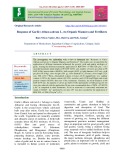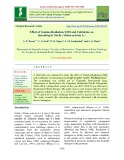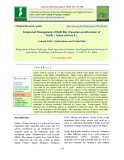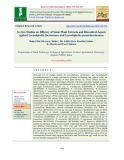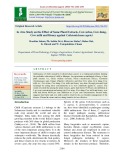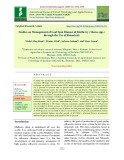
Garlic (A. sativum)
-
Alliinase is an important enzyme occurring in Allium species that converts precursors of sulfuric compounds, cysteine sulfoxides into a biologically active substance termed allicin. Allicin facilitates garlic defense against pests and produces health-promoting compounds.
 10p
10p  vinarcissa
vinarcissa
 21-03-2023
21-03-2023
 3
3
 1
1
 Download
Download
-
"Morphological characterisation and volatile analysis of Turkish garlic genotypes" aims to discriminate the garlic genotypes obtained from different cultivation locations in Turkey. For that purpose, firstly, morphological characters including biometric parameters were measured based on 18 morphological traits. Particular correlations related to the biometric parameters were calculated. Secondly, a total of 41 main volatiles in the bulbs of garlic genotypes were identified by using headspace-gas chromatography/mass spectrometry.
 17p
17p  lyhuyenthu
lyhuyenthu
 31-01-2023
31-01-2023
 5
5
 2
2
 Download
Download
-
In this study, the effect of methyl jasmonate (MeJA) treatments (10-3 and 10-5 M) and two different storage locations such as Ankara and Taşköprü, on some quality parameters, such as weight loss, L* values, soluble solids content, firmness, titratable acidity, total phenolic content, antioxidant capacity, vitamin C and allicin content in garlic bulbs (Allium sativum cv. ‘Taşköprü’) were investigated during a storage period of six months with three replications (30 bulbs or 120 g cloves).
 12p
12p  hanthienngao
hanthienngao
 30-11-2021
30-11-2021
 10
10
 1
1
 Download
Download
-
Garlic bulbs are abnormal expanding axillary buds that are rarely found among vascular plants. Bulbyield is one of the valuable agronomic traits of garlic. However, due to the large genome size and a strictly asexual life cycle in the cultivars, the genetic basis of the yield traits are poorly understood in garlic.
 9p
9p  visilicon2711
visilicon2711
 20-08-2021
20-08-2021
 12
12
 1
1
 Download
Download
-
The major nutrients nitrogen, phosphorus and potash play an important role in nutrition of garlic plants in relation to growth, yield and quality of bulb. The organic manure is an ecofriendly, economically viable and ecologically sound that also played a significant role in soil biology, chemistry and physics.
 8p
8p  cothumenhmong9
cothumenhmong9
 04-01-2021
04-01-2021
 9
9
 2
2
 Download
Download
-
A field trial was conducted to study the effect of Gamma Radiation, EMS and Colchicine on Sprouting percentage in garlic variety „Buldhana local‟. The experiment was carried out at Vegetable Instructional farm, Department of Horticulture, Dr. Panjabrao Deshmukh Krishi Vidyapeeth, Akola (M.S.) during Rabi season in the year 2017-2018.
 5p
5p  trinhthamhodang9
trinhthamhodang9
 16-12-2020
16-12-2020
 9
9
 1
1
 Download
Download
-
Garlic is a spice crop grown throughout the world. It is used all over the world as a valuable condiment for foods. It is also known for remedy or medicine for various ailments and physiological disorders. India is second largest producer of garlic in the world. Garlic planting, as well as harvesting, is labour intensive operation. The labor requirement for planting is approximately, 520 man-h/ha. Most of the planting of garlic is done manually with the help of hand tools like khurpi. Commercially, it is sown by the Khera method.
 9p
9p  caygaocaolon7
caygaocaolon7
 18-09-2020
18-09-2020
 14
14
 1
1
 Download
Download
-
The research was carried out for the management of bulb rot using organic amendments. Five organic amendments and a fungicide (treated check) were evaluated for their efficacy under in vitro and in vivo against bulb rot of garlic incited by Fusarium proliferatum, Carbendazim @ 0.1% as treated control was effective in the inhibition of mycelial growth (100%) of F. proliferatum followed by T3(Neem cake-46.98%), T5(Mustard cake-44.72%), T1(Vermicompost-37.68%), T2(FYM-34.29%), T4(Poultry manure28.89%).
 5p
5p  nguaconbaynhay7
nguaconbaynhay7
 15-08-2020
15-08-2020
 14
14
 1
1
 Download
Download
-
A field experiment was conducted at Horticulture Farm, S.K.N. College of Agriculture, Jobner (Jaipur) during Rabi season 2016-17 and 2017-2018. The experiment consisting four bio-fertilizers (control, Azotobacter, PGPR (Pseudomonas) and Azotobacter + PGPR (Pseudomonas) and five bio-regulators (control, Thiourea @ 500 ppm, Thiourea @ 1000 ppm, salicylic acid @ 100 ppm and mepiquat chloride @ 100 ppm).
 12p
12p  caygaocaolon6
caygaocaolon6
 30-07-2020
30-07-2020
 12
12
 1
1
 Download
Download
-
The genus Allium contains seven cultivated species of economic importance: the bulb onion (Allium cepa), aggregatum onion (A. cepa var. aggregatum L), shallot (A. cepa var. ascalonium), chive (A. schoenoprasum), Chinese chive (A. tuberosum), Japanese bunching onion (A. fistulosum), garlic (A. sativum), Leek (A. ampeloprasum var. porrum) and rakkyo (A. chinence). Of which, aggregatum onion Allium cepa var. aggregatum Don (2n= 16) is one of the important species of Allium vegetables as it forms an indispensable part of many diets, both vegetarian and non-vegetarian.
 19p
19p  angicungduoc6
angicungduoc6
 20-07-2020
20-07-2020
 7
7
 1
1
 Download
Download
-
Three botanicals viz. Neem (Azadirachta indica), Garlic (Allium sativum), Onion (Allium cepa) and a chemicals carbendazim(treated) were used in vivo (in field) at 10 per cent and 0.1% concentration. To check the disease intensity of web blight in mungbean. The minimum disease intensity and maximum disease control were recorded in garlic(value) followed by neem, onion, Trichoderma viride, T. harzianum as compared to treated and untreated check. The yield (value) and 100-seed weight were also recorded maximum in garlic (value) followed by neem, onion, Trichoderma viride, T.
 5p
5p  nguaconbaynhay6
nguaconbaynhay6
 23-06-2020
23-06-2020
 9
9
 0
0
 Download
Download
-
The effect of supplementation of garlic and nilavembu on haematological and biochemical parameters of commercial broiler chicken was studied in 300 commercial broiler for a period of six weeks. There were 5 treatment groups and each treatment had three replicates with 20 chicks.
 8p
8p  angicungduoc5
angicungduoc5
 14-06-2020
14-06-2020
 11
11
 0
0
 Download
Download
-
The present investigation entitled “Studies on the effect of macro and micro nutrients on yield and nutrient uptake in garlic (Allium sativum L.)” was conducted during Rabi season of 2015-16 at Horticultural Research and Training Station and KVK, Kandaghat of Dr. Yashwant Singh Parmar University of Horticulture and Forestry, Nauni, Solan. Ten combinations of different macro and micro nutrients were replicated thrice in the form of ten treatments in a plot having dimensions of 2.0x2.0m.
 4p
4p  nguathienthan5
nguathienthan5
 04-06-2020
04-06-2020
 13
13
 0
0
 Download
Download
-
Stem-end rot of mango caused by Lasiodiplodia theobromae and Lasiodiplodia pseudotheobromae is a major post-harvest problem in Manipur and reduces yield. An experiment on antifungal efficacy of three plant extracts viz., Garlic (Allium sativum), Neem (Azadirachta indica) and Ginger (Zingiber officinale) was done through poisoned food technique by taking three concentrations in in vitro conditions against the pathogens and eight Trichoderma isolates viz., T. ovalisporum (KU904456), T. koningiopsis (KU904460), T. harzianum (KU904458), T. atroviride (KU933472), T. harzianum (KU933474), T.
 10p
10p  nguaconbaynhay5
nguaconbaynhay5
 16-05-2020
16-05-2020
 22
22
 1
1
 Download
Download
-
Garlic is the second most important bulbous vegetables after onion and used as a spice and flavoring agent for foods. The present study was carried out at the Horticultural Research Centre, College of Agriculture, S.V.P. University of Agriculture and Technology, Meerut (U.P), India. The results revealed that more than 75% of diversity of the total 131 garlic germplasm is present in first 4 principal components out of 12 and they had Eigen values recorded more than 1.
 7p
7p  chauchaungayxua5
chauchaungayxua5
 08-05-2020
08-05-2020
 15
15
 0
0
 Download
Download
-
Anthracnose of chilli caused by Colletotrichum capsici is a widespread problem limiting the profitable cultivation of chilli in Manipur. An experiment on antifungal efficacy of four plant extracts viz., Garlic (Allium sativum), Neem (Azadirachta indica), Citronella (Cymbopogon spp), Ginger (Zingiber officinale) and three Cow urine, Cow dung, Cow milk viz., Cow urine, Cow dung, Cow milk and honey was done through poisoned food technique by setting three concentrations in in vitro conditions against C. capsici.
 8p
8p  chauchaungayxua5
chauchaungayxua5
 08-05-2020
08-05-2020
 11
11
 2
2
 Download
Download
-
A field trial was conducted at the Vegetable Research Farm, Department of Horticulture, Allahabad Agricultural Institute-Deemed University, and Allahabad, to study the performance of different varieties on growth, yield and quality of Garlic (Allium sativum L.) under agro-climatic conditions of Allahabad. The experiment was laid out in randomized block design comprising of seven varieties (Local check, Agrifound White, IC-35265, G-283, Kaveri, KS-2 and G-4), each replicated three times.
 6p
6p  quenchua4
quenchua4
 16-04-2020
16-04-2020
 5
5
 0
0
 Download
Download
-
A study was carried out to evaluate the efficacy of ten plant extracts against Phleospora maculans (Bereng) Allesch. both by inhibition zone technique and conidial germination technique on potato dextrose agar (PDA) medium each at three different concentrations viz. 5 percent, 10 percent and 15 percent with carbendazim 50WP (0.02%) as control. Among botanicals tested, the extract of Allium sativum (Garlic) has shown maximum inhibition of mycelial growth (66.45mm2 ), whereas, minimum inhibition was recorded in Morus alba (12.87mm2 ) irrespective of concentrations.
 9p
9p  trinhthamhodang1212
trinhthamhodang1212
 06-04-2020
06-04-2020
 13
13
 1
1
 Download
Download
-
A total of 144 day old broiler chicks (Cobb-400 Y) were randomly distributed into four groups (3 replicates of 12 chicks) using randomization block design viz. T0 contained no garlic powder supplementation while diet T1, T2 and T3 contained 0.5, 1.0 and 1.5% of garlic powder, respectively along with probiotic powder named probios.
 9p
9p  caygaocaolon2
caygaocaolon2
 11-03-2020
11-03-2020
 11
11
 0
0
 Download
Download
-
The present study was conducted to test anti -bacterial activity of garlic against Staphylococcus aureus and Escherichia coil. The antibacterial effects of Aqueous Garlic Extract (AGE) against gram-positive and gram-negative bacterial isolates, Staphylococcus aureus and Escherichia coli were studied. Antibacterial activity of different concentrations of Aqueous Garlic Extract (AGE) by Well- Diffusion Method. Garlic extract was used in the range of100 % to 5 % (1ml/mL, 0.5 ml/ ml, 0.25 ml/ml, 0.125 ml/ ml and 0.625 ml/mL), against Staphylococcus aureus and Escherichia coli respectively.
 9p
9p  caygaocaolon3
caygaocaolon3
 27-02-2020
27-02-2020
 15
15
 1
1
 Download
Download
CHỦ ĐỀ BẠN MUỐN TÌM












